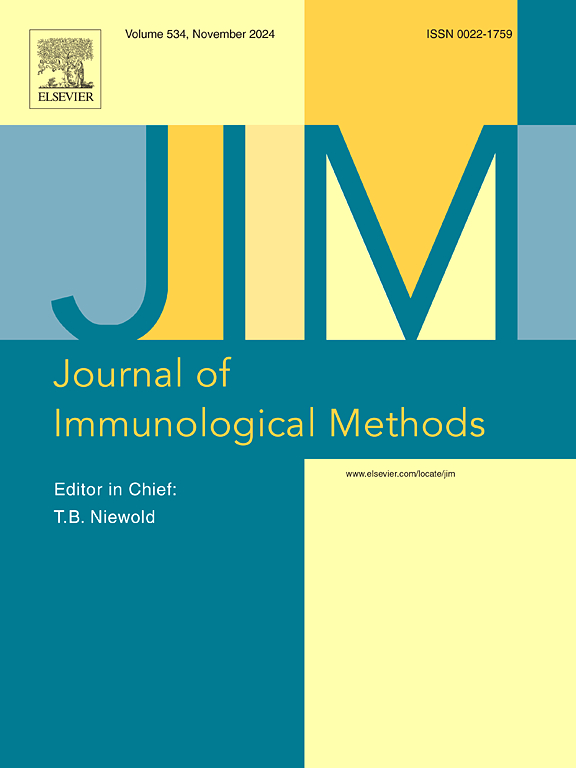IL-8切割抑制实验的表征,以确定人血清中抗spycep抗体的功能。
IF 1.6
4区 医学
Q4 BIOCHEMICAL RESEARCH METHODS
引用次数: 0
摘要
暴露于A群链球菌会导致广泛的疾病和后遗症,因为这种细菌利用广泛的毒力因子来促进宿主的定植、繁殖和向前传播,破坏先天和适应性免疫反应。蛋白酶SpyCEP通过破坏白细胞介素-8 (IL-8)的分裂而抑制中性粒细胞的募集和杀死细菌,在细菌免疫逃避中起着至关重要的作用。鉴于这一关键功能,SpyCEP是一种关键的疫苗抗原,定量测定功能性抗SpyCEP抗体不仅是疫苗有效性的重要标志,也是解剖自然免疫反应的工具。在这里,我们报道了IL-8切割抑制实验的发展和表征,以测量人血清中抗spycep抗体的功能。结果表明,该方法灵敏度高、特异性高、线性和可重复性好,适用于评估疫苗临床试验和自然免疫观察性研究中人体诱导的抗spycep抗体的功能。本文章由计算机程序翻译,如有差异,请以英文原文为准。
Characterization of an IL-8 cleavage inhibition assay to determine the functionality of anti-SpyCEP antibodies in human sera
Exposure to Group A Streptococcus leads to a broad spectrum of disease and sequelae, as the bacterium employs a wide range of virulence factors to facilitate colonization of the host, propagation and onward transmission, disrupting both innate and adaptive immune responses. The protease SpyCEP has a crucial role in contributing to bacterial immune evasion by impairing neutrophil recruitment and killing of bacteria through the cleavage of interleukin-8 (IL-8). Given this critical function, SpyCEP represents a key vaccine antigen and quantifying functional anti-SpyCEP antibodies represents not only an important marker of vaccine efficacy, but also a tool to dissect the natural immune response. Here, we report the development and characterization of an IL-8 cleavage inhibition assay to measure the function of anti-SpyCEP antibodies in human sera. The assay was demonstrated to be sensitive, highly specific, linear and reproducible, and suitable for evaluating the function of anti-SpyCEP antibodies induced in humans in vaccine clinical trials and in observational studies of natural immunity.
求助全文
通过发布文献求助,成功后即可免费获取论文全文。
去求助
来源期刊
CiteScore
4.10
自引率
0.00%
发文量
120
审稿时长
3 months
期刊介绍:
The Journal of Immunological Methods is devoted to covering techniques for: (1) Quantitating and detecting antibodies and/or antigens. (2) Purifying immunoglobulins, lymphokines and other molecules of the immune system. (3) Isolating antigens and other substances important in immunological processes. (4) Labelling antigens and antibodies. (5) Localizing antigens and/or antibodies in tissues and cells. (6) Detecting, and fractionating immunocompetent cells. (7) Assaying for cellular immunity. (8) Documenting cell-cell interactions. (9) Initiating immunity and unresponsiveness. (10) Transplanting tissues. (11) Studying items closely related to immunity such as complement, reticuloendothelial system and others. (12) Molecular techniques for studying immune cells and their receptors. (13) Imaging of the immune system. (14) Methods for production or their fragments in eukaryotic and prokaryotic cells.
In addition the journal will publish articles on novel methods for analysing the organization, structure and expression of genes for immunologically important molecules such as immunoglobulins, T cell receptors and accessory molecules involved in antigen recognition, processing and presentation. Submitted full length manuscripts should describe new methods of broad applicability to immunology and not simply the application of an established method to a particular substance - although papers describing such applications may be considered for publication as a short Technical Note. Review articles will also be published by the Journal of Immunological Methods. In general these manuscripts are by solicitation however anyone interested in submitting a review can contact the Reviews Editor and provide an outline of the proposed review.

 求助内容:
求助内容: 应助结果提醒方式:
应助结果提醒方式:


